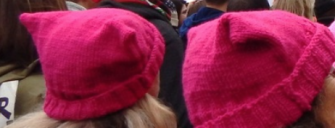
In the last few months, the hats in this photo have been springing up everywhere ...in malls, online and in marches. For those who haven’t seen them yet, they stem from the leaked recording of President Trump speaking about how he treated women. It was later explained away as just “locker-room talk”. It may have been forgotten by some, but not by two women in Los Angeles. LATimes.com reported:
“I wanted to do something more than just show up,” said the 29-year-old screenwriter who lives in downtown Los Angeles, recalling how her professors at the all-female Barnard College in New York City urged her to think about problems. “How can I visually show someone what’s going on? And I realized as a California girl, I would be really cold in D.C. -- it’s not tank-top weather year-round. So I thought maybe I could knit myself a hat.”... And so the “p....hat project” was born. Knitters -- mostly women -- started crafting handmade pink caps with cat ears, a reference to Trump’s vulgar statements...
While we will call them “pink hats”, they are also known widely as ‘p...y hats’, a name responsive to the Trump/Bush video that surfaced during the campaign. We have struggled with the name to use as we write this blog and have decided to maintain the color name rather than the sexual and demeaning slur word used by the then presidential candidate. We hope our choice doesn’t offend those to whom the name and the hat has taken on great power and significance.
What will happen when students and teachers arrive to school wearing pink hats? Of course, it may never happen but an anticipatory leadership plan might be useful. For some, pink hats are a symbol of defiance. For others, they are a sign of strength. For still others, they are a manifestation of being part of something significant. It caught on and pink hats were knitted and worn the day after the inauguration in Washington DC and in cities across the country and around the world as women (and men) marched. So, what if they come to school? School codes of conduct have prevented students from wearing offensive t-shirts, those advertising liquor, or drugs for example. Teachers have been asked not to wear clothing that promotes one candidate or another. Schools strive to be places where two sides of an issue can be investigated with open minds. That is what public education strives for doesn’t it?
What Will You Do?
Well, pink hats are on the line. First, it is important that a discussion with the adults decide what they are going to call those pink hats. Recall that during the campaign a fuss was made about Mrs. Trump donning a blouse with what is called in the fashion industry, a ‘p...y bow’. That name comes from the bows that were commonly placed around the neck of kittens and cats and are considered high fashion. Mrs. Trump was wearing Gucci then. But it wasn’t those blouses that dotted the malls and streets around the world. It was pink hats.
Surely among families and faculty there are supporters of the President. And we are just as sure that among families and faculty there are those who voted for someone else. Do leaders want to raise an issue before it arrives? Probably not. But, this one will blow up if leaders haven’t given it thought. As with so many things, the locality determines culture and relationships and, to some degree, the response. But with all that said, a plan in advance is important. Imagine, in a school where hats and caps are permitted. Students proudly wear hats and shirts boasting their favorite teams or colleges or vacation spots. Then, a girl wears one of those pink hats for the first time. It may be that some adults in the building don’t even know the back story to the pink hat and won’t even notice. But, someone will and controversy arises. What existing policy covers this issue? It will be good to have that at the ready and the media story also. Imagine the first time an informed high schooler brings up the subject in a social studies class while discussing current events. Will it result in an opportunity for rich discussion about values, women, respect, and the presidency?
Pink hats might offer educators an important opportunity to teach civics and ethics. Now the hats give educators another chance to teach civics. It is a touchy subject to use the words being used on the street in marketplace about these hats. What will those hats be called? In what grade will descriptions be different? How can you be sure all teachers will handle it the same way? All assistant principals? All principals?
Most high schools across the nation have classrooms where there have been discussions about the electoral college and its role in our democracy. So while teaching the value of law, tradition, and ceremony, there are other important lessons to be taught. One of great value can be understanding whatever you say can be recorded and whatever you put on the Internet is there forever. Imagine, for example, the discussions students are having on social media.They graduate, go on to college and want to become a Congressional aide. These are important ones. But, for now, a building-wide, district-wide discussion about how to react to those who are wearing pink hats is worthwhile. Discuss and decide.
Photo courtesy of Monroe Gilmour
Ann Myers and Jill Berkowicz are the authors of The STEM Shift (2015, Corwin) a book about leading the shift into 21st century schools. Connect with Ann and Jill on Twitter or Email.